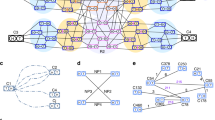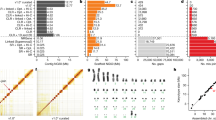Abstract
The completed draft version of the human genome, comprised of multiple short contigs encompassing 85% or more of euchromatin, was announced in June of 2000 (ref. 1). The detailed findings of the sequencing consortium were reported several months later2. The draft sequence has provided insight into global characteristics, such as the total number of genes and a more accurate definition of gene families. Also of importance are genome positional details such as local genome architecture, regional gene density and the location of transcribed units that are critical for disease gene identification. We carried out a series of mapping and computational experiments using a nonredundant collection of 925 expressed sequence tags (ESTs) and sections of the public draft genome sequence that were available at different timepoints between April 2000 and April 2001. We found discrepancies in both the reported coverage of the human genome and the accuracy of mapping of genomic clones, suggesting some limitations of the draft genome sequence in providing accurate positional information and detailed characterization of chromosomal subregions.
This is a preview of subscription content, access via your institution
Access options
Subscribe to this journal
Receive 12 print issues and online access
$209.00 per year
only $17.42 per issue
Buy this article
- Purchase on Springer Link
- Instant access to full article PDF
Prices may be subject to local taxes which are calculated during checkout




Similar content being viewed by others
References
Pennisi, E. Human genome. Finally, the book of life and instructions for navigating it. Science 288, 2304–2307 (2000).
International Human Genome Sequencing Consortium. Initial sequencing and analysis of the human genome. Nature 409, 860–921 (2001).
Altschul, S.F. et al. Gapped BLAST and PSI-BLAST: a new generation of protein database search programs. Nucleic Acids Res. 25, 3389–3402 (1997).
Katsanis, N. & Fisher, E.M. Identification, expression, and chromosomal localization of the ubiquitin conjugating enzyme 7 (UBE2G2), a human homologue of the Saccharomyces cerevisiae ubc7 gene. Genomics 51, 128–131 (1998).
Gyapay, G. et al. A radiation hybrid map of the human genome. Hum. Mol. Genet. 5, 339–346 (1996).
Deloukas, P. et al. A physical map of 30,000 human genes. Science 282, 744–746 (1998).
Katsanis, N. et al. Mutations in MKKS cause obesity, retinal dystrophy and renal malformations associated with Bardet-Biedl syndrome. Nature Genet. 26, 67–70 (2000).
Shizuya, H. et al. Cloning and stable maintenance of 300-kilobase-pair fragments of human DNA in Escherichia coli using an F-factor-based vector. Proc. Natl Acad. Sci. USA 89, 8794–8797 (1992).
Lupski, J.R. Genomic disorders: structural features of the genome can lead to DNA rearrangements and human disease traits. Trends Genet. 14, 417–422 (1998).
Olivier, M. et al. A high-resolution radiation hybrid map of the human genome draft sequence. Science 291, 1298–1302 (2001).
Katsanis, N. & Fisher, E.M. A novel C-terminal binding protein (CTBP2) is closely related to CTBP1, an adenovirus E1A-binding protein, and maps to human chromosome 21q21.3. Genomics 47, 294–299 (1998).
Acknowledgements
We thank Z. Yang for expert programming assistance and A. Beaudet and A. Bradley for critical review. This work was supported by the National Eye Institute, NIH, grants EY12666 to N.K. and K.C.W. and EY11780 to J.R.L. and by the Foundation Fighting Blindness.
Author information
Authors and Affiliations
Corresponding author
Rights and permissions
About this article
Cite this article
Katsanis, N., Worley, K. & Lupski, J. An evaluation of the draft human genome sequence. Nat Genet 29, 88–91 (2001). https://doi.org/10.1038/ng0901-88
Received:
Accepted:
Issue Date:
DOI: https://doi.org/10.1038/ng0901-88
This article is cited by
-
Segments missing from the draft human genome sequence can be isolated by transformation‐associated recombination cloning in yeast
EMBO reports (2003)
-
New bugs in the human genome draft
Genome Biology (2001)
-
Accessing genetic variation: genotyping single nucleotide polymorphisms
Nature Reviews Genetics (2001)



